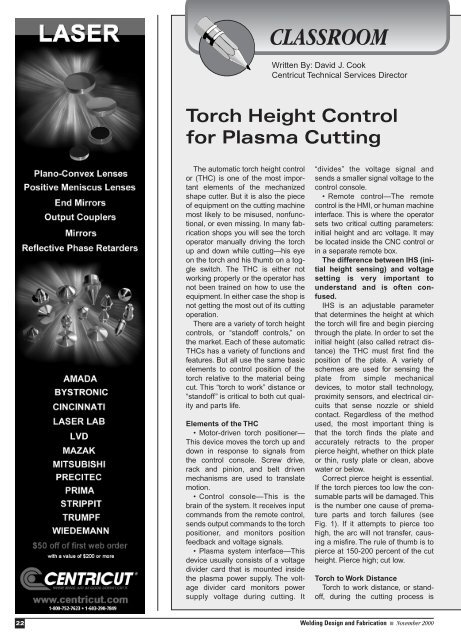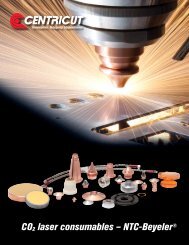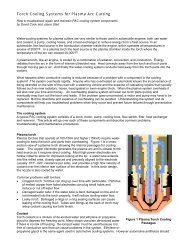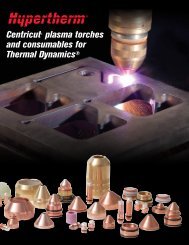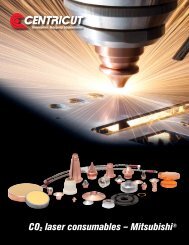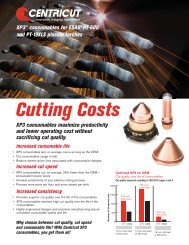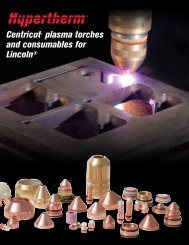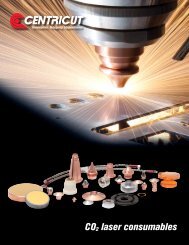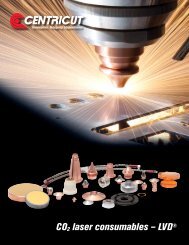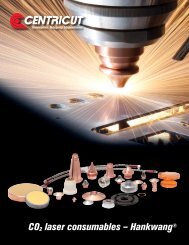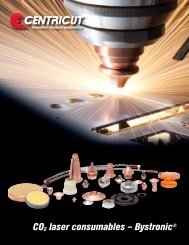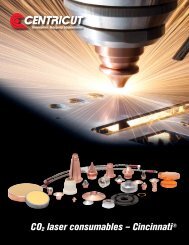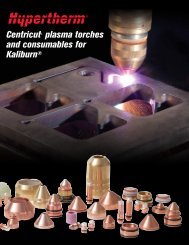Create successful ePaper yourself
Turn your PDF publications into a flip-book with our unique Google optimized e-Paper software.
CLASSROOMWritten By: David J. Cook<strong>Centricut</strong> Technical Services DirectorTorch Height Controlfor Plasma CuttingThe automatic torch height controlor (THC) is one of the most importantelements of the mechanizedshape cutter. But it is also the pieceof equipment on the cutting machinemost likely to be misused, nonfunctional,or even missing. In many fabricationshops you will see the torchoperator manually driving the torchup and down while cutting—his eyeon the torch and his thumb on a toggleswitch. The THC is either notworking properly or the operator hasnot been trained on how to use theequipment. In either case the shop isnot getting the most out of its cuttingoperation.There are a variety of torch heightcontrols, or “standoff controls,” onthe market. Each of these automaticTHCs has a variety of functions andfeatures. But all use the same basicelements to control position of thetorch relative to the material beingcut. This “torch to work” distance or“standoff” is critical to both cut qualityand parts life.Elements of the THC• Motor-driven torch positioner—This device moves the torch up anddown in response to signals fromthe control console. Screw drive,rack and pinion, and belt drivenmechanisms are used to translatemotion.•Control console—This is thebrain of the system. It receives inputcommands from the remote control,sends output commands to the torchpositioner, and monitors positionfeedback and voltage signals.• Plasma system interface—Thisdevice usually consists of a voltagedivider card that is mounted insidethe plasma power supply. The voltagedivider card monitors powersupply voltage during cutting. It“divides” the voltage signal andsends a smaller signal voltage to thecontrol console.• Remote control—The remotecontrol is the HMI, or human machineinterface. This is where the operatorsets two critical cutting parameters:initial height and arc voltage. It maybe located inside the CNC control orin a separate remote box.The difference between IHS (initialheight sensing) and voltagesetting is very important tounderstand and is often confused.IHS is an adjustable parameterthat determines the height at whichthe torch will fire and begin piercingthrough the plate. In order to set theinitial height (also called retract distance)the THC must first find theposition of the plate. A variety ofschemes are used for sensing theplate from simple mechanicaldevices, to motor stall technology,proximity sensors, and electrical circuitsthat sense nozzle or shieldcontact. Regardless of the methodused, the most important thing isthat the torch finds the plate andaccurately retracts to the properpierce height, whether on thick plateor thin, rusty plate or clean, abovewater or below.Correct pierce height is essential.If the torch pierces too low the consumableparts will be damaged. Thisis the number one cause of prematureparts and torch failures (seeFig. 1). If it attempts to pierce toohigh, the arc will not transfer, causinga misfire. The rule of thumb is topierce at 150-200 percent of the cutheight. Pierce high; cut low.Torch to Work DistanceTorch to work distance, or standoff,during the cutting process is22Welding Design and Fabrication ■ November 2000


